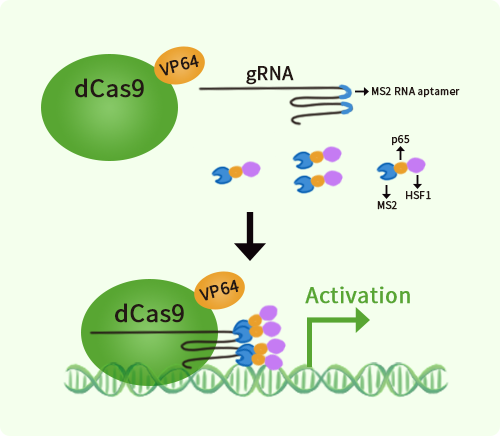Human GRP78 (HSPA5) activation kit by CRISPRa
CAT#: GA102261
HSPA5 CRISPRa kit - CRISPR gene activation of human heat shock protein family A (Hsp70) member 5
Find the corresponding CRISPRi Inhibitor Kit
USD 1,290.00
2 Weeks*
Specifications
| Product Data | |
| Format | 3gRNAs, 1 scramble ctrl and 1 enhancer vector |
| Symbol | HSPA5 |
| Locus ID | 3309 |
| Kit Components | GA102261G1, GRP78 gRNA vector 1 in pCas-Guide-GFP-CRISPRa GA102261G2, GRP78 gRNA vector 2 in pCas-Guide-GFP-CRISPRa GA102261G3, GRP78 gRNA vector 3 in pCas-Guide-GFP-CRISPRa 1 CRISPRa-Enhancer vector, SKU GE100056 1 CRISPRa scramble vector, SKU GE100077 |
| Disclaimer | The kit is designed based on the best knowledge of CRISPa SAM technology. The efficiency of the activation can be affected by many factors, including nucleosome occupancy status, chromatin structure and the gene expression level of the target, etc. |
| Reference Data | |
| RefSeq | NM_005347 |
| Synonyms | BIP; GRP78; HEL-S-89n; MIF2 |
| Summary | 'The protein encoded by this gene is a member of the heat shock protein 70 (HSP70) family. This protein localizes to the lumen of the endoplasmic reticulum (ER) where it operates as a typical HSP70 chaperone involved in the folding and assembly of proteins in the ER and is a master regulator of ER homeostasis. During cellular stress, as during viral infection or tumorogenesis, this protein interacts with the transmembrane stress sensor proteins PERK (protein kinase R-like endoplasmic reticulum kinase), IRE1 (inositol-requiring kinase 1), and ATF6 (activating transcription factor 6) where it acts as a repressor of the unfolded protein response (UPR) and also plays a role in cellular apoptosis and senescence. Elevated expression and atypical translocation of this protein to the cell surface has been reported in viral infections and some types of cancer cells. At the cell surface this protein may facilitate viral attachment and entry to host cells. This gene is a therapeutic target for the treatment of coronavirus diseases and chemoresistant cancers. [provided by RefSeq, Jul 2020]' |
Documents
| Product Manuals |
| FAQs |
Resources
Other Versions
| SKU | Description | Size | Price |
|---|---|---|---|
| KN205859 | HSPA5 - human gene knockout kit via CRISPR, HDR mediated |
USD 1,290.00 |
|
| KN205859BN | HSPA5 - human gene knockout kit via CRISPR, HDR mediated |
USD 1,290.00 |
|
| KN205859LP | HSPA5 - human gene knockout kit via CRISPR, HDR mediated |
USD 1,290.00 |
|
| KN205859RB | HSPA5 - human gene knockout kit via CRISPR, HDR mediated |
USD 1,290.00 |
|
| KN405859 | HSPA5 - KN2.0, Human gene knockout kit via CRISPR, non-homology mediated. |
USD 1,290.00 |
{0} Product Review(s)
Be the first one to submit a review






























































































































































































































































 Germany
Germany
 Japan
Japan
 United Kingdom
United Kingdom
 China
China
